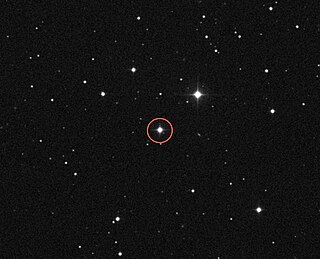
Back Gliese 445 AST Gliese 445 German Gliese 445 Spanish گلیزه ۴۴۵ Persian Gliese 445 French גליזה 445 HE ग्लीज़ ४४५ Hindi Gliese 445 ID グリーゼ445 Japanese 글리제 445 Korean
| Observation data Epoch J2000.0 Equinox J2000.0 (ICRS) | |
|---|---|
| Constellation | Camelopardalis |
| Right ascension | 11h 47m 41.3885s[1] |
| Declination | +78° 41′ 28.179″[1] |
| Apparent magnitude (V) | 10.80[2] |
| Characteristics | |
| Spectral type | M4.0Ve[3] |
| B−V color index | 1.572[2] |
| Astrometry | |
| Radial velocity (Rv) | −111.707[1] km/s |
| Proper motion (μ) | RA: 748.111[1] mas/yr Dec.: 480.804[1] mas/yr |
| Parallax (π) | 190.3251 ± 0.0194 mas[4] |
| Distance | 17.137 ± 0.002 ly (5.2542 ± 0.0005 pc) |
| Absolute magnitude (MV) | 12.227[5] |
| Details | |
| Mass | 0.14[6] M☉ |
| Radius | 0.285[5] R☉ |
| Luminosity | 0.008[7] L☉ |
| Surface gravity (log g) | 4.72[7] cgs |
| Temperature | 3,507[1] K |
| Metallicity [Fe/H] | −0.30[5] dex |
| Rotational velocity (v sin i) | <2.5[8] km/s |
| Other designations | |
| Database references | |
| SIMBAD | data |
| ARICNS | data |
Location of Gliese 445 in the constellation Camelopardalis | |
Gliese 445 (Gl 445 or AC +79 3888) is an M-type main sequence star in the northern part of the constellation Camelopardalis.
- ^ a b c d e f Brown, A. G. A.; et al. (Gaia collaboration) (August 2018). "Gaia Data Release 2: Summary of the contents and survey properties". Astronomy & Astrophysics. 616. A1. arXiv:1804.09365. Bibcode:2018A&A...616A...1G. doi:10.1051/0004-6361/201833051. Gaia DR2 record for this source at VizieR.
- ^ a b Urban, S. E.; Zacharias, N.; Wycoff, G. L.; Observatory, U. S. Naval; Washington, D. C. (2004). "VizieR Online Data Catalog: The UCAC2 Bright Star Supplement (Urban+, 2006)". VizieR On-line Data Catalog. Bibcode:2004yCat.1294....0U.
- ^ Lépine, Sébastien; Hilton, Eric J.; Mann, Andrew W.; Wilde, Matthew; Rojas-Ayala, Bárbara; Cruz, Kelle L.; Gaidos, Eric (2013). "A Spectroscopic Catalog of the Brightest (J < 9) M Dwarfs in the Northern Sky". The Astronomical Journal. 145 (4): 102. arXiv:1206.5991. Bibcode:2013AJ....145..102L. doi:10.1088/0004-6256/145/4/102. S2CID 117144290.
- ^ Brown, A. G. A.; et al. (Gaia collaboration) (2021). "Gaia Early Data Release 3: Summary of the contents and survey properties". Astronomy & Astrophysics. 649: A1. arXiv:2012.01533. Bibcode:2021A&A...649A...1G. doi:10.1051/0004-6361/202039657. S2CID 227254300. (Erratum: doi:10.1051/0004-6361/202039657e). Gaia EDR3 record for this source at VizieR.
- ^ a b c Houdebine, Éric R.; Mullan, D. J.; Doyle, J. G.; de la Vieuville, Geoffroy; Butler, C. J.; Paletou, F. (2019). "The Mass-Activity Relationships in M and K Dwarfs. I. Stellar Parameters of Our Sample of M and K Dwarfs". The Astronomical Journal. 158 (2): 56. arXiv:1905.07921. Bibcode:2019AJ....158...56H. doi:10.3847/1538-3881/ab23fe. S2CID 159041104.
- ^ Gaidos, E.; Mann, A. W.; Lépine, S.; Buccino, A.; James, D.; Ansdell, M.; Petrucci, R.; Mauas, P.; Hilton, E. J. (2014). "Trumpeting M dwarfs with CONCH-SHELL: A catalogue of nearby cool host-stars for habitable exoplanets and life". Monthly Notices of the Royal Astronomical Society. 443 (3): 2561. arXiv:1406.7353. Bibcode:2014MNRAS.443.2561G. doi:10.1093/mnras/stu1313. S2CID 119234492.
- ^ a b McDonald, I.; Zijlstra, A. A.; Watson, R. A. (2017). "Fundamental parameters and infrared excesses of Tycho-Gaia stars". Monthly Notices of the Royal Astronomical Society. 471 (1): 770. arXiv:1706.02208. Bibcode:2017MNRAS.471..770M. doi:10.1093/mnras/stx1433. S2CID 73594365.
- ^ Stelzer, B.; Marino, A.; Micela, G.; López-Santiago, J.; Liefke, C. (2013). "The UV and X-ray activity of the M dwarfs within 10 pc of the Sun". Monthly Notices of the Royal Astronomical Society. 431 (3): 2063. arXiv:1302.1061. Bibcode:2013MNRAS.431.2063S. doi:10.1093/mnras/stt225. S2CID 119193975.
- ^ "GJ 445". SIMBAD. Centre de données astronomiques de Strasbourg. Retrieved July 29, 2008.

